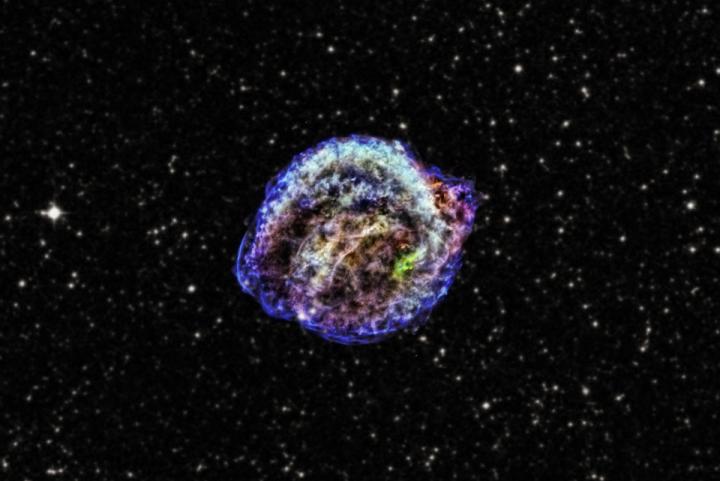Explosion or collapse?

Light from the stellar explosion that created this energized cosmic cloud was first seen on planet Earth in October 1604, a mere 400 years ago. The supernova produced a bright new star in early 17th century skies within the constellation Ophiuchus. It was studied by astronomer Johannes Kepler and his contemporaries. Recent data has shown relative elemental abundances typical of a Type Ia supernova, and further indicated that the progenitor was a white dwarf star that exploded when it accreted too much material from a companion. The explosions discussed in the publication would produce a remnant that looks like Kepler but with the presence of an oxygen-neon-iron white dwarf at the center. Picture: X-ray: NASA/CXC/NCSU/M. Burkey et al.; Optical: DSS
A group of scientists, among them several from GSI Helmholtzzentrum für Schwerionenforschung and from Technical University of Darmstadt, succeeded to experimentally determine characteristics of nuclear processes in matter ten million times denser and 25 times hotter than the centre of our Sun.
A result of the measurement is that intermediate-mass stars are very likely to explode, and not, as assumed until now, collapse. The findings are now published in the scientific magazine Physical Review Letters.
They stress the fascinating opportunities offered by future accelerator facilities like FAIR in understanding the processes defining the evolution of the Universe.
Stars have different evolutionary paths depending on their mass. Low-mass stars such as the Sun will eventually become white dwarfs. Massive stars, on the other hand, finish with a spectacular explosion known as a supernova, leaving either a neutron star or a black hole behind.
The fate of both low- and high-mass stars is well understood but the situation for intermediate-mass stars, which weigh between seven and eleven times as much as the Sun, has remained unclear. This is surprising since intermediate-mass stars are prevalent in our Galaxy.
“The final fate of intermediate-mass stars depends on a tiny detail, namely, how readily the isotope neon-20 captures electrons in the stellar core. Depending on this electron capture rate, the star will be either disrupted in a thermonuclear explosion or it will collapse to form a neutron star,” explains Professor Gabriel Martínez-Pinedo of GSI's research department Theory and the Institut für Kernphysik, TU Darmstadt.
Professor Karlheinz Langanke, Research Director of GSI and FAIR, adds: “This work started when we realized that a strongly suppressed, and hence previously ignored and experimentally unknown, transition between the ground states of neon-20 and fluorine-20 was a key piece of information needed to determine the electron capture rate in intermediate mass stars.”
By a combination of precise measurements of the beta-decay of fluorine-20 and theoretical calculations, an international collaboration of physicists with participation from GSI and TU Darmstadt, has now succeeded in determining this important rate.
The experiment took place under conditions far more peaceful than those found in stars, namely at the Accelerator Laboratory of the University of Jyväskylä. The measurements showed a surprisingly strong transition between the ground states of neon-20 and fluorine-20 that leads to electron capture in neon-20 occurring at lower density than previously believed.
For the star, this implies that, in contrast to previous assumptions, it is more likely to be disrupted by a thermonuclear explosion than to collapse into a neutron star.
“It is amazing to find out that a single transition can have such a strong impact on the evolution of a big object like a star,” says Dag Fahlin Strömberg, who, as a PhD student at TU Darmstadt, was responsible for large parts of project's simulations.
Since thermonuclear explosions eject much more material than those triggered by gravitational collapse, the results have implications for galactic chemical evolution. The ejected material is rich in titanium-50, chromium-54, and iron-60.
Therefore, the unusual titanium and chromium isotopic ratios found in some meteorites, and the discovery of iron-60 in deep-sea sediments could be produced by intermediate-mass stars and indicate that these have exploded in our galactic neighbourhood in the distant (billions of years) and not so distant (millions of years) past.
In the light of these new findings the most probable fate of intermediate-mass stars seems to be a thermonuclear explosion, producing a subluminous type Ia supernova and a special type of white dwarf star known as an oxygen-neon-iron white dwarf.
The (non-)detection of such white dwarfs in the future would provide important insights into the explosion mechanism. Another open question is the role played by convection — the bulk movement of material in the interior of the star — in the explosion.
At existing and future accelerator centres like the international FAIR project (Facility for Antiproton and Ion Research) currently under construction at GSI, new not yet investigated isotopes and their properties can be investigated. Thus, scientists continue to bring the universe into the laboratory to answer the unsolved questions about our cosmos.
Media Contact
All latest news from the category: Physics and Astronomy
This area deals with the fundamental laws and building blocks of nature and how they interact, the properties and the behavior of matter, and research into space and time and their structures.
innovations-report provides in-depth reports and articles on subjects such as astrophysics, laser technologies, nuclear, quantum, particle and solid-state physics, nanotechnologies, planetary research and findings (Mars, Venus) and developments related to the Hubble Telescope.
Newest articles

NASA: Mystery of life’s handedness deepens
The mystery of why life uses molecules with specific orientations has deepened with a NASA-funded discovery that RNA — a key molecule thought to have potentially held the instructions for…

What are the effects of historic lithium mining on water quality?
Study reveals low levels of common contaminants but high levels of other elements in waters associated with an abandoned lithium mine. Lithium ore and mining waste from a historic lithium…

Quantum-inspired design boosts efficiency of heat-to-electricity conversion
Rice engineers take unconventional route to improving thermophotovoltaic systems. Researchers at Rice University have found a new way to improve a key element of thermophotovoltaic (TPV) systems, which convert heat…



